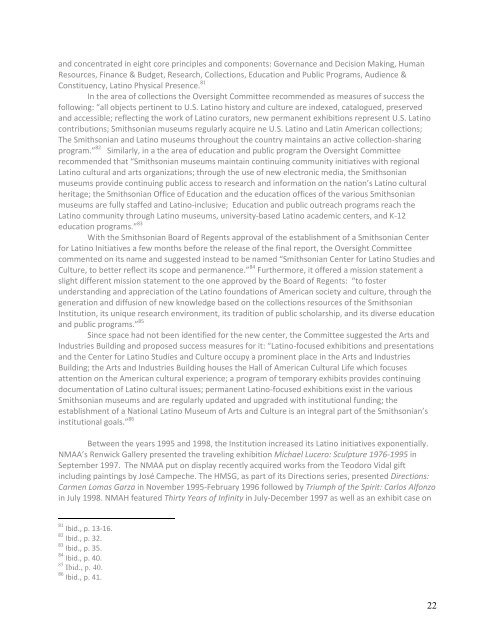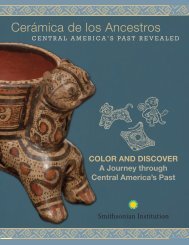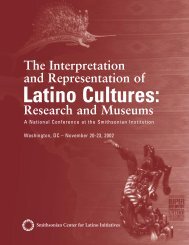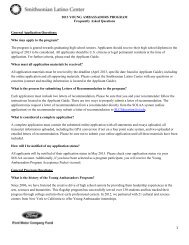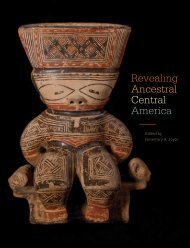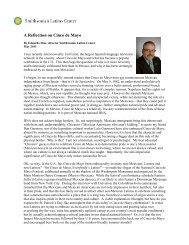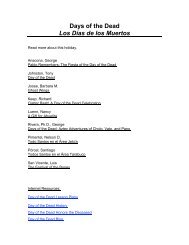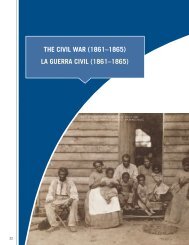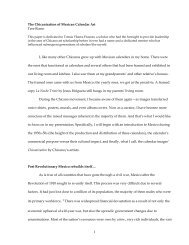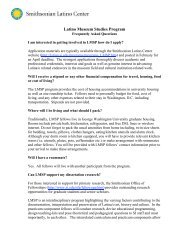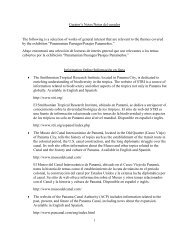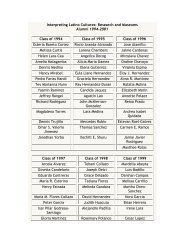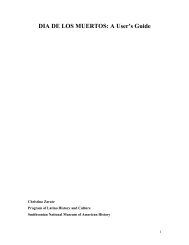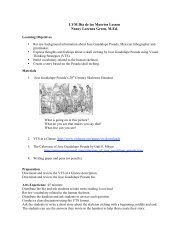smithsonian latino art collections - Smithsonian Latino Center
smithsonian latino art collections - Smithsonian Latino Center
smithsonian latino art collections - Smithsonian Latino Center
Create successful ePaper yourself
Turn your PDF publications into a flip-book with our unique Google optimized e-Paper software.
and concentrated in eight core principles and components: Governance and Decision Making, Human<br />
Resources, Finance & Budget, Research, Collections, Education and Public Programs, Audience &<br />
Constituency, <strong>Latino</strong> Physical Presence. 81<br />
In the area of <strong>collections</strong> the Oversight Committee recommended as measures of success the<br />
following: “all objects pertinent to U.S. <strong>Latino</strong> history and culture are indexed, catalogued, preserved<br />
and accessible; reflecting the work of <strong>Latino</strong> curators, new permanent exhibitions represent U.S. <strong>Latino</strong><br />
contributions; <strong>Smithsonian</strong> museums regularly acquire ne U.S. <strong>Latino</strong> and Latin American <strong>collections</strong>;<br />
The <strong>Smithsonian</strong> and <strong>Latino</strong> museums throughout the country maintains an active collection-sharing<br />
program.” 82 Similarly, in a the area of education and public program the Oversight Committee<br />
recommended that “<strong>Smithsonian</strong> museums maintain continuing community initiatives with regional<br />
<strong>Latino</strong> cultural and <strong>art</strong>s organizations; through the use of new electronic media, the <strong>Smithsonian</strong><br />
museums provide continuing public access to research and information on the nation’s <strong>Latino</strong> cultural<br />
heritage; the <strong>Smithsonian</strong> Office of Education and the education offices of the various <strong>Smithsonian</strong><br />
museums are fully staffed and <strong>Latino</strong>-inclusive; Education and public outreach programs reach the<br />
<strong>Latino</strong> community through <strong>Latino</strong> museums, university-based <strong>Latino</strong> academic centers, and K-12<br />
education programs.” 83<br />
With the <strong>Smithsonian</strong> Board of Regents approval of the establishment of a <strong>Smithsonian</strong> <strong>Center</strong><br />
for <strong>Latino</strong> Initiatives a few months before the release of the final report, the Oversight Committee<br />
commented on its name and suggested instead to be named “<strong>Smithsonian</strong> <strong>Center</strong> for <strong>Latino</strong> Studies and<br />
Culture, to better reflect its scope and permanence.” 84 Furthermore, it offered a mission statement a<br />
slight different mission statement to the one approved by the Board of Regents: “to foster<br />
understanding and appreciation of the <strong>Latino</strong> foundations of American society and culture, through the<br />
generation and diffusion of new knowledge based on the <strong>collections</strong> resources of the <strong>Smithsonian</strong><br />
Institution, its unique research environment, its tradition of public scholarship, and its diverse education<br />
and public programs.” 85<br />
Since space had not been identified for the new center, the Committee suggested the Arts and<br />
Industries Building and proposed success measures for it: “<strong>Latino</strong>-focused exhibitions and presentations<br />
and the <strong>Center</strong> for <strong>Latino</strong> Studies and Culture occupy a prominent place in the Arts and Industries<br />
Building; the Arts and Industries Building houses the Hall of American Cultural Life which focuses<br />
attention on the American cultural experience; a program of temporary exhibits provides continuing<br />
documentation of <strong>Latino</strong> cultural issues; permanent <strong>Latino</strong>-focused exhibitions exist in the various<br />
<strong>Smithsonian</strong> museums and are regularly updated and upgraded with institutional funding; the<br />
establishment of a National <strong>Latino</strong> Museum of Arts and Culture is an integral p<strong>art</strong> of the <strong>Smithsonian</strong>’s<br />
institutional goals.” 86<br />
Between the years 1995 and 1998, the Institution increased its <strong>Latino</strong> initiatives exponentially.<br />
NMAA’s Renwick Gallery presented the traveling exhibition Michael Lucero: Sculpture 1976-1995 in<br />
September 1997. The NMAA put on display recently acquired works from the Teodoro Vidal gift<br />
including paintings by José Campeche. The HMSG, as p<strong>art</strong> of its Directions series, presented Directions:<br />
Carmen Lomas Garza in November 1995-February 1996 followed by Triumph of the Spirit: Carlos Alfonzo<br />
in July 1998. NMAH featured Thirty Years of Infinity in July-December 1997 as well as an exhibit case on<br />
81 Ibid., p. 13-16.<br />
82 Ibid., p. 32.<br />
83 Ibid., p. 35.<br />
84 Ibid., p. 40.<br />
85 Ibid., p. 40.<br />
86 Ibid., p. 41.<br />
22


